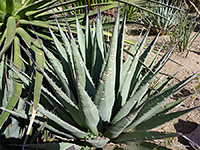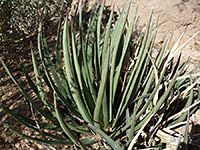Agave are succulent plants, meaning their leaves retain water and hence are thick and fleshy. Leaves radiate from a short central stem, and are protected by a long spine at the tip and (usually) by rows of equally sharp teeth along the edges. Plants favor desert environments, especially in Mexico, but the range extends across most of south and southwest USA, where just over 20 species are found, out of a total of over 200. Agave are sometimes known as century plants owing to their habit of flowering only once, when aged; flowers (inflorescence) are borne along the upper portion of a tall stalk (scape) that in some species reaches a height of 30 feet. Some species look similar but tend to grow in distinct, non-overlapping regions which aids identification.
Other US agave species, all non native, hybrids or otherwise uncommon:
Agave delamateri, Tonto Basin agave, central Arizona - a rare plant, probably an ancient cultivar
Agave desmettiana, dwarf agave, south Florida
Agave glomeruliflora, Chisos agave, far west Texas - probably a hybrid species
Agave neglecta, small agave, south Florida (rare)
Agave parviflora, small-flowered agave, south Arizona (rare)
Agave weberi, Weber's agave, south Texas (non native)
Agave yavapaiensis, Page Springs agave, central Arizona
Other US agave species, all non native, hybrids or otherwise uncommon:
Agave delamateri, Tonto Basin agave, central Arizona - a rare plant, probably an ancient cultivar
Agave desmettiana, dwarf agave, south Florida
Agave glomeruliflora, Chisos agave, far west Texas - probably a hybrid species
Agave neglecta, small agave, south Florida (rare)
Agave parviflora, small-flowered agave, south Arizona (rare)
Agave weberi, Weber's agave, south Texas (non native)
Agave yavapaiensis, Page Springs agave, central Arizona
All Contents © Copyright The American Southwest | Comments and Questions | Contribute | Affiliate Marketing Disclosure | Site Map


















